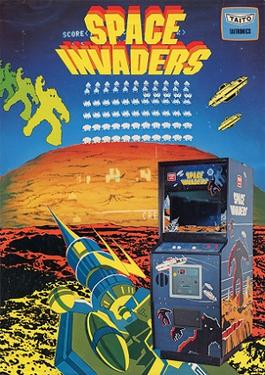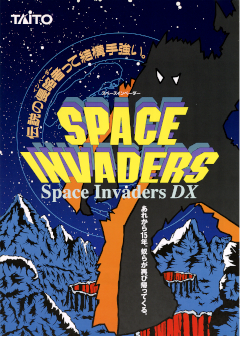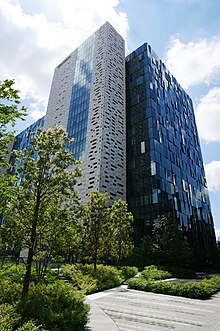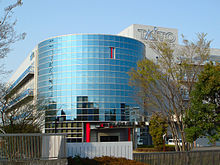
Space Invaders is a 1978 shoot 'em up arcade video game, developed and released by Taito in Japan and licensed to Midway Manufacturing for overseas distribution. Commonly considered to be one of the most influential video games of all time, Space Invaders was the first fixed shooter and set the template for the genre. The goal is to defeat wave after wave of descending aliens with a horizontally moving laser cannon to earn as many points as possible.

Arkanoid is a 1986 block breaker arcade game developed and published by Taito. In North America, it was published by Romstar. Controlling a paddle-like craft known as the Vaus, the player is tasked with clearing a formation of colorful blocks by deflecting a ball towards it without letting the ball leave the bottom edge of the playfield. Some blocks contain power-ups that have various effects, such as increasing the length of the Vaus, creating several additional balls, or equipping the Vaus with cannons. Other blocks may be indestructible or require multiple hits to break.

Square Enix Holdings Co., Ltd. is a Japanese multinational holding company, video game publisher and entertainment conglomerate. It releases role-playing game franchises, such as Final Fantasy, Dragon Quest, and Kingdom Hearts, among numerous others. Outside of video game publishing and development, it is also in the business of merchandise, arcade facilities, and manga publication under its Gangan Comics brand.

Irem Software Engineering is a Japanese video game console developer and publisher, and formerly a developer and manufacturer of arcade games as well. The company has its headquarters in Chiyoda, Tokyo.
Zuntata is the "house band" of Japanese video game developer and publisher Taito. The band consists of sound director Katsuhisa Ishikawa, bassists Yu Shimoda and Shohei Tsuchiya, and drummer Masaki Mori. Zuntata is Taito's core sound department, and has become the collective name for the company's other sound production teams. The band has contributed to many of the company's franchises, including Darius, Groove Coaster, Arkanoid, and Space Invaders.

Breakout is an arcade video game developed and published by Atari, Inc. and released on May 13, 1976. It was designed by Steve Wozniak, based on conceptualization from Nolan Bushnell and Steve Bristow, who were influenced by the seminal 1972 Atari arcade game Pong. In Breakout, a layer of bricks lines the top third of the screen and the goal is to destroy them all by repeatedly bouncing a ball off a paddle into them. The arcade game was released in Japan by Namco. Breakout was a worldwide commercial success, among the top five highest-grossing arcade video games of 1976 in both the United States and Japan and then among the top three highest-grossing arcade video games of 1977 in the US and Japan. The 1978 Atari VCS port uses color graphics instead of a monochrome screen with colored overlay.

Elevator Action is a platform shooter game released in arcades by Taito in 1983. The player assumes the role of Agent 17, a spy infiltrating a 30-story building filled with elevators and enemy agents who emerge from closed doors. The goal is to collect secret documents from specially marked rooms, then escape the building. It runs on the Taito SJ System arcade system.

Tomohiro Nishikado is a Japanese video game developer and engineer. He is the creator of the arcade shoot 'em up game Space Invaders, released to the public in 1978 by the Taito of Japan, often credited as the first shoot 'em up and for beginning the golden age of arcade video games. Prior to Space Invaders, he also designed other earlier Taito arcade games, including the shooting electro-mechanical games Sky Fighter (1971) and Sky Fighter II, the sports video game TV Basketball in 1974, the vertical scrolling racing video game Speed Race in 1974, the multi-directional shooter Western Gun in 1975, and the first-person combat flight simulator Interceptor (1975).

Gun Fight, known as Western Gun in Japan and Europe, is a 1975 multidirectional shooter arcade game designed by Tomohiro Nishikado, and released by Taito in Japan and Europe and by Midway in North America. Based around two Old West cowboys armed with revolvers and squaring off in a duel, it was the first video game to depict human-to-human combat. The Midway version was also the first video game to use a microprocessor instead of TTL. The game's concept was adapted from Sega's 1969 arcade electro-mechanical game Gun Fight.
1975 had new titles such as Western Gun, Dungeon and dnd. The year's best-selling arcade game was Taito's Speed Race, released as Wheels and Wheels II in North America.
Michael "Misha" Kogan was a Ukrainian entrepreneur who founded the Japanese video game company Taito.

Yoichi Wada is a former president and representative director of the Japanese video game and publishing company Square Enix as well as its subsidiary Taito. He is also the former chairman of the Computer Entertainment Supplier's Association (CESA), the former chairman of the Digital Content Use Promotion Conference, former president of Shinra Technologies and a former member of the Japanese Brand and Contents Council. He is a current outside director of Metaps.

Arkanoid DS is a breakout video game developed by Taito and published by Square Enix for the Nintendo DS. It was released on December 6, 2007.

Space Invaders DX is a 1993 fixed shooter arcade game developed and published in Japan by Taito. It has been re-released for several consoles since, including the Super Nintendo Entertainment System, PC Engine Super CD, and Sega Saturn — several of these conversions use the name Space Invaders: The Original Game. The player assumes control of a laser base that must fend off waves of incoming enemies, who march down in formation towards the bottom of the screen. It is the fifth entry in the long-running Space Invaders series. DX contains four variations of the original Space Invaders, in addition to a multiplayer mode and a "Parody Mode" that replaces the characters with those from other Taito franchises. Home ports of DX received mixed reviews for their high price point and general lack of content.

Speed Race is a 1974 arcade racing video game developed and manufactured by Taito and released under the titles Racer and Wheels in North America by distributor Midway Manufacturing in 1975. Designed by Tomohiro Nishikado, the gameplay involves the player using the attached steering wheel to maneuver a car alongside a fast vertical scrolling road. The objective is to score points by driving past other cars without colliding with them; more points are awarded for driving faster. Players must do this under a 90-second time limit, which ends the game when it runs out. The gameplay concepts were adapted from two earlier driving electro-mechanical games: Kasco's Mini Drive (1958) and Taito's Super Road 7 (1970).

Taito of Brazil was a pinball and arcade manufacturer located in São Paulo, Brazil. The company originally started out as Clover Electronic Amusement in 1968, then became Taito of Brazil in 1972 by Abraham "Abba" Kogan, the son of the founder of the parent company Taito located in Japan. This subsidiary was originally an importer of existing U.S. and Japanese machine components to be assembled within the country. However, the taxation on imports had been growing steadily, and the government's belief that pinball is a game of chance and considered a gambling machine, led to strict import rules. By 1976, within rules created by the Electronic Processing Activities Coordinating Committee (CAPRE), it became illegal to import pinball machines. This created a problem, since the popularity of arcade games in Brazil had been growing exponentially for many years.

Arkanoid vs Space Invaders is a paid mobile game developed by Taito and published by Taito in Japan and Square Enix worldwide. As the name suggests, it is a crossover between Arkanoid and Space Invaders and has gameplay elements adapted from both games. The game was released without any prior announcement by Square Enix internationally on May 17, 2017. It was re-released on Nintendo Switch and PlayStation 4 as part of Space Invaders Invincible Collection and Space Invaders Forever.


















